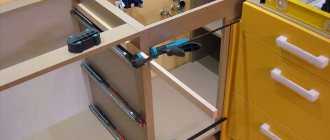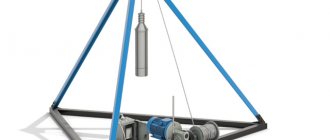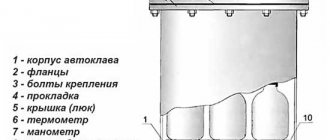The grinder is a necessary thing in the household. You can put a cutting and grinding wheel, various attachments and even a saw on it. The tool is powerful, so it must be used with extreme caution. And the material you are working with must be securely fixed. Craftsmen have been experimenting on this topic for a long time and offering various devices for ease of work. Some of them are complex structures, stationary and bulky, which are mounted on a workbench. This is not always convenient, because, for example, laying a long pipe or corner on a workbench will not work. Much more valuable would be a simple, compact device that can be easily moved to the work site. This is exactly the option proposed by the author of the YouTube channel Manual Arc Welding. The cost of materials for such a device is cheap, and it is very easy to assemble it with minimal welding skills.
Safety regulations
The grinder is a dangerous object with enormous momentum. If you do not follow the instructions for use, you can be seriously injured. Before starting work and making a homemade stand for an angle grinder, be sure to read the safety rules.
1. When cutting hard materials, various particles of metal or stone and sharp fragments fly out from under the abrasive wheel. The first reliable remedy against debris flying in the face of the master is closed-type safety glasses. There are cases where the circle itself is broken. Shards can hit the glasses and break them, so glasses should be reinforced, with a protective mesh. Don't be stingy, it's your health.
2. The grinder must have a screen surrounding the knives. Some workers, when putting on a large diameter circle, remove the casing that interferes with movement. Also, when making a stand for an angle grinder with your own hands, you can get rid of it altogether. Under no circumstances should this be done. It is placed without fail and in such a way that the operator is behind it. Thus, the fragments are knocked off the casing and fly in the opposite direction.
Tools and materials
As a rule, at home, a stand for an angle grinder is made from profiled metal pipes, as they are very durable and reliable. Although some craftsmen make holders from lumber. In this case, it is advisable to use only the hardest types of wood that can withstand heavy loads and not deform during operation. As for metal structures, the problem here is only the need to use electric welding and the ability to work with it. However, if you think about it a little, most welding work can be replaced by drilling, that is, using bolted connections. In addition, this option will allow you to almost completely disassemble the machine.
For work you will need the following materials and tools:
- welding machine;
- perforator;
- sander;
- metal corner;
- profiled pipes and channels;
- powerful spring;
- relay 12 Volt;
- bolts, nuts and a set of keys;
- panel made of chipboard or metal (working surface).
Stand for grinder
When working with this tool, many craftsmen have to perform monotonous, identical cuts. Holding it in your hand, it is very difficult to achieve evenness of the strip. Strong rotations and vibration do not allow a person to hold the product exactly in one position; the hand will definitely move. To prevent this from happening, buy a stand for the grinder.
But under strong constant loads and vibrations, the parts of the stand become loose and crack. Yes, and it is mainly designed to work with a circle of maximum 125 mm. The big one won't fit there. If you want a stand for an angle grinder that is strong and reliable, then the best option would be to make it yourself. Self-production will add confidence in the quality of the fasteners, and the master will work calmly.
Sheet steel cutting machine
The main parts of such a machine:
- Base. Ideally, it should be no smaller than the sheet that is supposed to be cut with a grinder, or allow the entire cutting area to be laid on it. It is necessary to use steel as a manufacturing material so that it absorbs heat, preventing the steel cutting line from overheating.
- U-shaped stand. This structural element serves as a guide for pulling the angle grinder through. The length of the section between the legs of the stand should be sufficient to place a sheet between them, plus allow the body of the angle grinder to fit freely.
- The carriage is a movable element that moves along a U-shaped stand on bearings. A pendulum console and a depth limiter for lowering the cutting disc are attached to it.
- The pendulum console serves as a mechanism for lowering the angle grinder to the level of the working position. Also attached to it is a tool control handle.
Small device for home use
This do-it-yourself stand for an angle grinder is made only for use at home, for small jobs. It is made from plywood and wooden blocks. The tool itself is installed stationary and does not move. Take two sheets of plywood. A grinder is secured to the bottom square with clamps and a beam in the form of a stand is screwed on.
The second part on furniture hinges is placed on top. A slot is cut for the abrasive wheel. The advantage of this arrangement is that the master does not hold the tool in his hands. Also, the circle is partially visible and cannot fly out, causing injury to the operator. Such an easy-to-use device is suitable for cutting small metal corners, aluminum profiles, and ceramic tiles.
Reliable stops and clamps
All five photographs show various devices for clamping a part, all of them are good and convenient in their own way and, nevertheless, from them you can choose the most correct solution. The most reliable and reliable fastening option is a vice.
- They securely fix the workpiece.
- You don't need to hold it with your hands.
- If the disk breaks during a cut, it is extremely difficult to hold the part in your hands, and if it is in a vice, the risk of injury is reduced.
- And if you purchase a rotary vice and make a longitudinal groove at the base of the stand to move the fasteners along the cutting line, then you will be able to make an oblique cut, which increases the functionality of your machine.
Welded metal structure
When making this model, you need to have a drawing of a stand for an angle grinder of your size.
The work is done from a metal profile and tubes using a welding machine. The platform for the stand must be heavy and capable of withstanding high-power vibrations. Next, the upper part is made, to which the tool itself is attached along with the casing. The bolted structure is installed to a welded corner on two metal legs.
In order for the angle grinder stand to move smoothly, the top and bottom panels are connected by a strong spring, for which holes are drilled. A guide angle is welded onto the platform at right angles to the circle.
DIY circular magnetic attachment for an angle grinder
Hello, dear readers and DIYers!
Many of you work with a grinder quite often, and sometimes the task of cutting circles from sheet metal arises. It is almost impossible to perform this task manually with high accuracy and without post-processing. In this article, the author of the YouTube channel “Samodelkin Ivan” will tell you how he made a special attachment for an angle grinder, with which you can cut circles of even large diameters without drilling a hole in the center.
This device is quite simple to make, but a small amount of welding work is required.
Materials. — Neodymium magnet for screw — Steel stud, extended nut M16 — Ball bearing 6001RS, housing — Steel profile pipes 25X25 20X20, strip 40 mm — Nut, bolt, wing nut M10.
Tools used by the author. — Grinder, cutting disc — Welding machine — Vise, hammer, marker. Manufacturing process. One of the main elements of this design will be a powerful neodymium magnet; these are often used in various search operations. A cylindrical elongated nut with an outer diameter of 12 mm is already welded to the reverse side of this magnet.
The first step is to press the 6001RS ball bearing into the housing.
A hole with a diameter of 10 mm is drilled in the center of the opposite side of the part, then an M10 nut is welded, and a clamping bolt is screwed into it. A wing nut is welded to the head of the bolt (you can immediately take an M10 bolt with a wing head).
A piece of M16 stud is screwed into the elongated nut, and the second part of the holder is screwed onto it.
Now the master needs to make a mount for the grinder. Two blanks like this are cut out from a 40-gauge steel strip, and M10 holes are drilled into them. Sharp edges of parts are processed with a flap cleaning disc.
Both parts are screwed to the standard holes for the handle on the angle grinder.
A part in the form of a trapezoid is cut out from the same strip and welded to the first two.
A similar, short part is also being made, which will later be welded to the mount on the grinder.
It remains to make two more parts like this for the hinge joint.
All parts are ready and are connected to each other with M10 bolts and nuts.
The neodymium magnet is very powerful, and it is almost impossible to tear it off the metal surface, so the author prudently places a piece of cardboard to slightly reduce the force.
The holder is magnetized to the sheet and the guide is inserted into it.
Then the desired radius is adjusted and the guide is fixed with a thumbscrew.
All that remains is to adjust the vertical position of the grinder and the disk so that it touches the surface of the workpiece.
The second edge of the guide is also a handle; by slightly lifting it, the disk is pressed against the workpiece.
The stainless steel sheet from which the master cuts the circle is quite thick, and the disc wears out quickly. After several passes in a circle, the author lowers the upper part of the structure using a stud and nut.
So, we got an excellent circle from a stainless steel sheet 4.5 mm thick.
Once again about the purpose of the parts of the device. This articulated joint allows you to adjust not only the distance from the spindle to the workpiece (this is necessary both when the disks wear out and for their different diameters), but also to set the desired cutting angle.
The second unit will allow you to more accurately adjust the height as the disc gradually wears out; for this purpose, a lock nut is screwed onto the stud. According to the author, this device will allow you to cut circles up to two meters in diameter.
Good mood, good health, and interesting ideas to everyone!
The author's video can be found here.
Source
Become the author of the site, publish your own articles, descriptions of homemade products and pay for the text. Read more here.
Pendulum stand
What’s good about a pendulum-shaped stand for an angle grinder is that it simplifies the sawing process. Due to the support on the table and the system of this design, you can perform work of varying complexity and trim materials of any density. With such a device, you do not need to apply much effort; the pressure is carried out by the mass of the tool itself.
To make this version of the stand you will need a spring, two hinges, a metal profile, corners and a welding machine. It is also advisable to have a strong iron table on which the entire structure can be installed. Having skills in such work, the master will quickly make such a pendulum. It is much easier to work if the handle is long and comfortable. The fingers are at a safe distance. No bending required. Sparks and debris fly in the opposite direction. And having a free approach to the table, you can perform work with large materials and products. It is convenient and allows you to perform a variety of processes.
When choosing a rack that suits you in all respects, do not forget about safety precautions. Then work will bring only joy.
Grinder cutting machine
In order to understand how to make a cutting machine from an angle grinder (angle grinder), you can look at various drawings on the Internet. But they will be of little help, since all the dimensions of the parts will still have to be selected based on the size of the grinder you have. Options for making devices can be either simple or more complex, requiring the ability to operate a welding machine.
Option 1
To make this device for an angle grinder, you will need welding skills. So, you need to do the following.
First, cut 2 small pieces from the corner (50x50 mm). Their size is selected based on the dimensions of the gearbox of your angle grinder.
Next, drill holes with a diameter of 14 mm in them and screw the corners to the angle grinder, as shown in the following photo. If you do not have suitable bolts, you can use M14 threaded studs. Just be careful that the bolts are not too long. Otherwise, in some models of angle grinders they may cling to the impeller located in the gearbox housing.
Without removing the corners from the angle grinder, secure them by welding. After this, the corners can be removed and scalded well.
Sand the weld seams using a grinder attachment.
Then you need to make a rotating support for the lever on which the device will be mounted. To do this, select 2 pipes of such diameters that one can fit into the other without much effort.
For a more precise cut, you can glue masking tape to the tubes and draw a line on it.
Then, turning the tube, carefully cut it with an angle grinder. A piece of pipe with a smaller diameter should be 20 mm shorter (the thickness of 2 bearings) - it will serve as a spacer.
For a thicker pipe, select 2 bearings suitable for its inner diameter. After this, insert the thin tube into the thick one and press the bearings on both sides.
Then insert the pin into the bearings. Be sure to place a washer in front of the nut.
When the rotating mechanism is ready, you need to weld a small piece of corner to it.
At the next stage, a stand for the rotating mechanism is made from the same 50x50 mm corner. To ensure that the pieces are the same length, the corners can be tightened with a clamp and trimmed.
Also, without unscrewing the clamp, they can be drilled immediately.
Attach the angles with drilled holes to the ready-made rotary block using nuts.
Weld a longer corner to this rack, as shown in the following photos.
Now you need to decide on the length of the lever on which the angle grinder will be attached. This is done by selection based on the dimensions of your angle grinder. You can lay out the parts on the table and calculate the approximate dimensions of the lever, which is best made from 2 pieces of square profile pipe 20x20 mm.
The pipes also need to be clamped with a clamp and cut to the same size.









